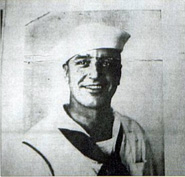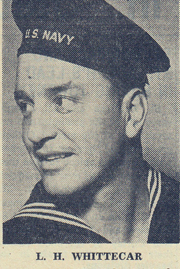Helps Keep Off Torpedoes by Laying Barrage of Bullets in Icy Waters
Battle Subs for Four Nights in Bad Sea Weather
Laying down a barrage to keep a pack of submarines from a large convoy through four consecutive icy nights, with the thought that momentarily a torpedo would come crashing into the ship sending it to the bottom—that was the experience of Gunner’s Mate L. H. “Spike” Whittecar, Moville resident operator.
Whittecar, home on leave from Uncle Sam’s Navy, has many stories to relate of convoy duty in the north Atlantic. He told how for four nights he stood by a gun on an armed merchantman and kept firing in a semicircle into the darkness to keep the subs off.
Seas ran 35 to 40 feet high throughout those nights, he said, adding to the difficulties and misery of the weary gunners.
A crew on a ship near his was torpedoed and the men were thrown into the raging, icy waters twice in one night, Whittecar said.
“They were on a tanker which was torpedoed and sank almost immediately, throwing the men into the water,” he related.
“Most of them were hauled from the water onto a Norwegian vessel, but before they could get warm another torpedo sent that ship to the bottom with all hands again thrown into the water.”
On the return trip, the empty convoy again was hounded by subs for a night but eluded them without the loss of a ship Whittecar again stood by his gun all night and kept up a steady tattoo of bullets on the water.
“We saw oil on the water more than once, a pretty good sign that some underseas prowler had gone to Davy Jones’ Locker,” the sailor said.
Whittecar has made two convoy trips across the Atlantic and three coastwise journeys since last October. He will return to active duty Sunday. His mother, Mrs. Melena Whittecar, lives at Salix.
Source: The Sioux City Journal-Tribune, March 12, 1943 (photo included)
![]()
Our Neighbors in the Services.
Salix, Iowa—L.H. Whittecar, naval gunner’s mate, third class, spent a few days visiting his mother and friends here and friends at Moville. He returned recently from North Africa and will report soon to New York.
Source: The Sioux City Journal, July 9, 1943
![]()
BIO:
LuVerne Henry ‘Spike’ Whittecar was born 11 March 1904, at Covington, Nebraska, to Stephen ‘Cy’ and Melina (Lamoine) Whittecar. The family moved to Salix, Iowa, where he attended St. Joseph Catholic School. Siblings are: Sterl, Harlan, Ambrosia, Lura, and Madeline.
Spike looked to have a promising career playing baseball. At one time, he signed with the St. Louis Cardinals, but because of an accident, his promising career was gone. He was standing on the side of a load of corn pushing down the corn when an airplane flew over very low, scaring the horses, knocking Spike to the ground and the load of corn running over hi. He was in a body cast for four months, thus ending his hopes and dreams of baseball.
Spike moved to Moville in 1934 to set up a restaurant business.
Spike enlisted in the Navy in June 1942, from Sioux City. He served as an Armed Guard Gunner on merchant ships; doing convoy duty during most of the time he was in the service. For 9 1⁄2 months, during the Italian campaign, he was part of the 5th Army, shuttle running from Anzio in Italy, and Bizerte in northern Africa, and taking part in the invasion of Southern France, transferring troops and supplies for the Fifth. He made, in all, twelve trips across the Atlantic, carrying troops and supplies on the way over, and sometimes returning loaded with prisoners.
The following appeared in the Stars and Stripes, “Sailors in Rome – Seems almost unbelievable – Three sailors entering Rome with the Fifth Army. The trail blazers for the navy were Coxswain Luverne H. Whittecar of Moville, Ia., G.M. 2- c Stewart Wright of Washington, and G.M. 2-c Lee Frey of York, Pa. Their ship was tied up in Naples harbor and they had been granted 24 hours liberty. The trio wandered about the city of Naples for a half hour but there wasn’t much to do. Let’s go up and see how the boys at the front are doing.
There being no room for argument, the sailors started up the road which led to Rome. Traveling in jeeps, trucks and by the primitive expedient of walking, they finally caught up with forward moving lines of doughboys. Where in the hell do you think you guys are going? Came the cries from the ranks of soldiers plodding toward the Eternal City.
Whatchado – lose a battleship around here? The sailors were quick with their replies, We came up to see what was holding you guys up, they bantered. We’ve cleared up everything on the sea. Not long afterward they learned that the Fifth army had already entered Rome, so the boys continued their journey. At noon, June 5th, the navy, in person of three sailors on liberty, together with soldiers of the advancing army, entered Rome. The boys have proof that they were the first sailors to spend a night in the historic capital. Their proof consists of pictures of an Italian family, which quartered them for the night. No better argument could be advanced to show the close cooperation between the army and navy in this war.”
Spike received his discharge on 4th August 1945, and returned home to Moville. He married Esther Wink on 21 February 1944, in the Norfolk, Virginia Naval Chapel. Two children were born to this union, Dennis and Deanna.
Spike left us 16 July 1983, of heart failure, at a Sioux City hospital. He is buried in Moville, in the Arlington Township Cemetery.
Submitted by his wife, Esther Whittecar.
![]()


